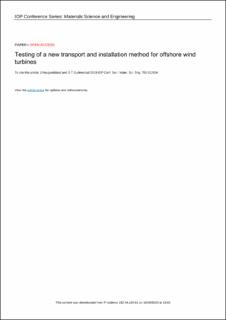| dc.contributor.author | Haugvaldstad, Jørn | |
| dc.contributor.author | Gudmestad, Ove Tobias | |
| dc.date.accessioned | 2023-01-18T11:02:35Z | |
| dc.date.available | 2023-01-18T11:02:35Z | |
| dc.date.created | 2019-12-05T12:52:08Z | |
| dc.date.issued | 2019 | |
| dc.identifier.citation | Haugvaldstad, J., & Gudmestad, O. T. (2019, November). Testing of a new transport and installation method for offshore wind turbines. In IOP Conference Series: Materials Science and Engineering (Vol. 700, No. 1, p. 012004). IOP Publishing. | en_US |
| dc.identifier.issn | 1757-8981 | |
| dc.identifier.uri | https://hdl.handle.net/11250/3044252 | |
| dc.description.abstract | Transport and installation of offshore wind turbines require considerable efforts and can be time consuming, in particular when jackups are used for lifting operations. This is mainly due to the specific weather window requirements for towing and locating the jackups. A goal is ultimately to finalize all turbine assembly work onshore and at quayside and to transport the completed turbine to the site for easy installation. We suggest that this can be achieved by a transport and installation method we denote "the MINT method" whereby the wind turbine foundation is located on a barge while the tower is resting on a support system, a "MINT" system that is located at the stern of a mid-size standard offshore support vessel. The MINT is specifically designed for the transport and installation operations allowing relative motions and rotations between the tower and the transport vessel. In order to qualify the "MINT installation method", a numerical study of the feasibility of the transport and installation was carried out by Sintef Ocean using their SIMO software package [1]. The method was found feasible in favourable weather conditions. To further document feasibility, it was decided to carry out a proof of concept test in a wave tank to identify concerns with respect to the suggested method for transport and installation. This paper reports the findings of this test. The test is to be considered to represent an initial activity in the concept qualification process, see [2], and is not a full wave tank test carried out to measure stresses and strains for member sizing. The objective of the paper is therefore, to show how an initial wave tank test can be useful for concept qualification. | en_US |
| dc.language.iso | eng | en_US |
| dc.publisher | IOP Publishing | en_US |
| dc.rights | Navngivelse 4.0 Internasjonal | * |
| dc.rights.uri | http://creativecommons.org/licenses/by/4.0/deed.no | * |
| dc.title | Testing of a new transport and installation method for offshore wind turbines | en_US |
| dc.type | Peer reviewed | en_US |
| dc.type | Journal article | en_US |
| dc.description.version | publishedVersion | en_US |
| dc.rights.holder | The authors | en_US |
| dc.subject.nsi | VDP::Teknologi: 500 | en_US |
| dc.source.pagenumber | 10 | en_US |
| dc.source.volume | 700 | en_US |
| dc.source.journal | IOP Conference Series: Materials Science and Engineering | en_US |
| dc.source.issue | 1 | en_US |
| dc.identifier.doi | 10.1088/1757-899X/700/1/012004 | |
| dc.identifier.cristin | 1757127 | |
| cristin.ispublished | true | |
| cristin.fulltext | original | |
| cristin.qualitycode | 1 | |

